Related Research Articles
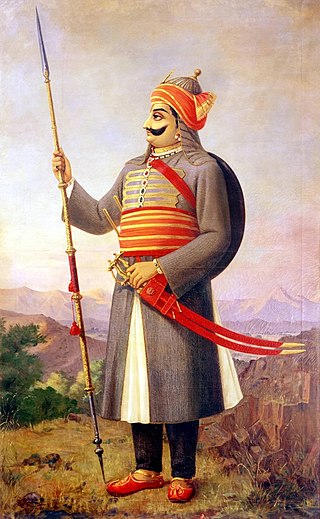
Pratap Singh I, popularly known as Maharana Pratap, was a king of Kingdom of Mewar, in north-western India in the present-day state of Rajasthan. He is notable for leading the Rajput resistance against the expansionist policy of the Mughal Emperor Akbar including the Battle of Haldighati.

RajaTodar Mal was an Indian minister, economist, and military commander who served as the Finance Minister (Diwan-i-Ashraff) of the Mughal empire during the reign of Akbar I. He was also the Vakil-us-Sultanat and Joint Wazir. He was one of the premier nobles in the Mughal Empire and was a Mansabdar of 4000. He was one of the Navaratnas in Akbar's court. Under Todar Mal, there were 15 other Dewans nominated for 15 Subahs of Akbar.
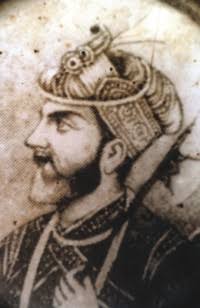
Isa Khan was the leader of the 16th-century Baro-Bhuiyan chieftains of Bengal. During his reign, he successfully unified the chieftains of Bengal and resisted the Mughal invasion of Bengal. It was only after his death that the region fell totally under Mughal control. He remains an iconic figure throughout West Bengal and Bangladesh as a symbol of his rebellious spirit and unity.

The Battle of Tukaroi, also known as the Battle of Bajhaura or the Battle of Mughulmari, was fought between the Mughal Empire and the Bengal Sultanate on 3 March 1575 near the village of Tukaroi in present-day Balasore District of Odisha. It resulted in a Mughal victory and greatly weakened the Bengal Sultanate.
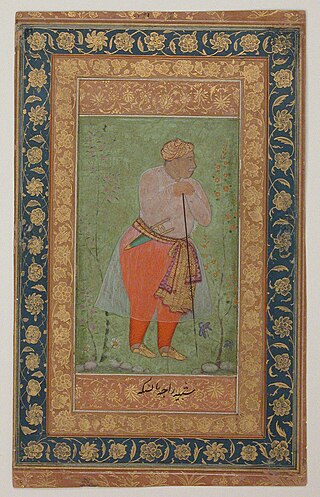
Mirza RajaMan Singh I was the 24th Maharaja of Amber from 1589 to 1614. He also served as the Subahdar of Bengal for three terms from 1595 to 1606 and the Subahdar of Kabul from 1585 to 1586. He served in the Imperial Mughal Army under Emperor Akbar. Man Singh fought sixty-seven important battles in Kabul, Balkh, Bukhara, Bengal and Central and Southern India. He was well versed in the battle tactics of both the Rajputs as well as the Mughals. He is commonly considered to be one of the Navaratnas, or the nine (nava) gems (ratna) of the royal court of Akbar.
Muslim Rajputs or Musalman Rajpoots are the descendants of Rajputs in the northern regions of the Indian subcontinent who generally are followers of Islam. Reportedly, they converted from Hinduism to Islam from the medieval period onwards, creating various dynasties and states while retaining Hindu surnames such as Chauhan. Today, Muslim Rajputs can be found mostly in present-day Northern India and Pakistan. They are further divided into different clans.
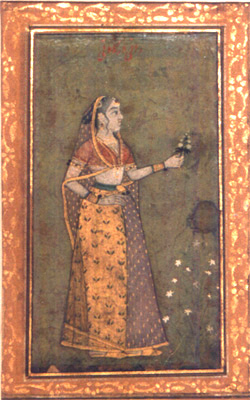
Rani Durgavati was the queen regent of Gondwana in 1550–1564 AD. She married King Dalpat Shah, the son of King Sangram Shah of Gondwana. She served as regent of Gondwana during the minority of her son, Vir Narayan, from 1550 until 1564. She is chiefly remembered for defending Gondwana against the Mughal Empire.
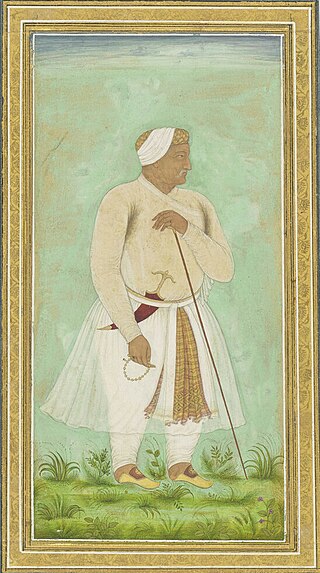
Raja Bhagwant Das was the 23rd Kacchwaha ruler of Amber.He also served as the Subahdar of Lahore and the Subahdar of Kabul for a few months in 1586. His sister, Mariam-uz-Zamani, was the chief consort of Mughal emperor Akbar. His son, Man Singh I, one of the Navaratnas of Akbar became the highest-ranking official of his court and his daughter, Man Bai, was the first and chief wife of Prince Salim.

Raja Bharmal, also known as Bihari Mal, and Bihar Mal, was the 22nd Kachwaha Rajput ruler of Amber, which was later known as Jaipur.
The Darbhanga Raj, also known as Raj Darbhanga and the Khandwala dynasty, was a Maithil Brahmin dynasty and the rulers of territories, not all contiguous, that were part of the Mithila region, now divided between India and Nepal.

Shahrullah Kamboh, better known as Shahbaz Khan Kamboh, was one of the leading generals of Mughal emperor Akbar. He participated in some of the most difficult expeditions of Akbar and annexed numerous territories to the empire. The Mughal officials boasted that he conquered countries ten times the size of Deccan. He was too orthodox a Sunni Muslim for Akbar's taste, but not only was he tolerated but also was greatly valued. He was named "Mang Khan" by the people of Lahore meaning "ask the Khan and it will be done" In Punjabi due to his legendary generosity. The very first 'guzar' in Lahore Fort was named Guzar Shahbaz Khan known locally as Guzar Mang Khan.

Daud Khan Karrani was the last ruler of Bengal's Karrani dynasty as well as the final Sultan of Bengal, reigning from 1572 to 1576. During the reign of his father Sulaiman Khan Karrani, Daud commanded a massive army of 40,000 cavalry, 3,600 elephants, 140,000 infantry and 200 cannons.

Lālah Beg, better known as Jahāngīr Qulī Beg and later as Jahāngīr Qulī Khān, was the Subahdar (governor) of Bengal between 1607 and 1608, during the reign of Mughal emperor Jahangir.
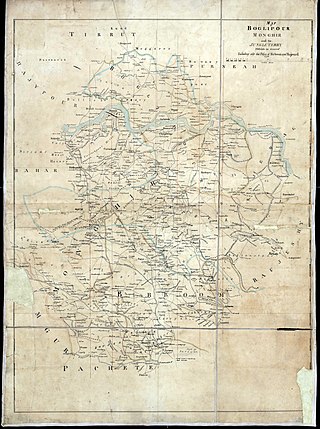
Kharagpur Raj was a prominent chieftaincy, founded in the early 16th century in Bihar situated mainly in modern-day Munger district. They were notable for being one of the few chieftaincies in Bihar to convert to Islam and many of the rulers became firm allies of the Mughal authorities. At its peak, the Kharagpur Raj encompassed parts of the modern-day districts of Munger, Bhagalpur, Jamui, Lakhisarai, Godda and Deoghar. Due to its size, the Privy Council compared it with the Kingdom of Sardinia.
The Chero dynasty or Chyavana dynasty was a polity that ruled the northern regions of the Indian subcontinent, corresponding to the present-day Indian states of Bihar, Uttar Pradesh, and Jharkhand, after the fall of the Pala Empire; their rule lasted from the 12th century CE to the middle of the 15th century.
Madhu Karn Shah also known as Madhu Singh was a Nagvanshi king in the 16th century. His capital was at Khukhragarh.

The Mughal conquest of Malwa was a military campaign launched by the Mughal Empire in 1560 during the reign of Akbar against the Sultanate of Malwa, which had broken free from Mughal rule during the rebellion of Sher Shah Suri from the emperor Humayun. Thus, Akbar had a claim to the province. Baz Bahadur had been the governor of Malwa in the Sur Empire but broke away after the death of Sher Shah.

The Gidhaur Chieftaincy was a principality which controlled parts of South Bihar for much of the medieval period in India. The chieftaincy was named after the town of Gidhaur in Jamui district but its territory extended into the wider region.

Bhojpur Kadim is a historic village in Dumraon block of Buxar district, Bihar, India. As of 2011, its population was 18,243, in 3,024 households. Together with the neighboring Bhojpur Jadid, it lends its name to the surrounding Bhojpuri region.
Puran Mal was king of Gidhaur in the 16th century. He was contemporary of Mughal Emperor Akbar. According to legend, he restored Baidyanath Temple of Deoghar.
References
- 1 2 3 4 5 6 7 Tahir Hussain Ansari (20 June 2019). Mughal Administration and the Zamindars of Bihar. Routledge. pp. 234–240. ISBN 978-1-00-065152-2.
- ↑ Yogendra P. Roy (1993). "Raja Roz Afzun of Kharagpur (AD 1601 - 31)". Proceedings of the Indian History Congress. 54: 357–358. JSTOR 44142975.
- ↑ Yogendra Roy (1998). "Landed Aristocracy and the Peasantry in Medieval Bhagalpur". Proceedings of the Indian History Congress. 59: 279–286. JSTOR 44146998.
- ↑ Ahmed Raza Khan (1987). "Chieftains in Bihar During the Mughal Period". Proceedings of the Indian History Congress. 48: 197–205. JSTOR 44141673.
- ↑ Yogendra Roy (2001). "Significance of Teliagarhi Fort during the Seventeenth Century". Proceedings of the Indian History Congress. 62: 1069–1077. JSTOR 44155847.